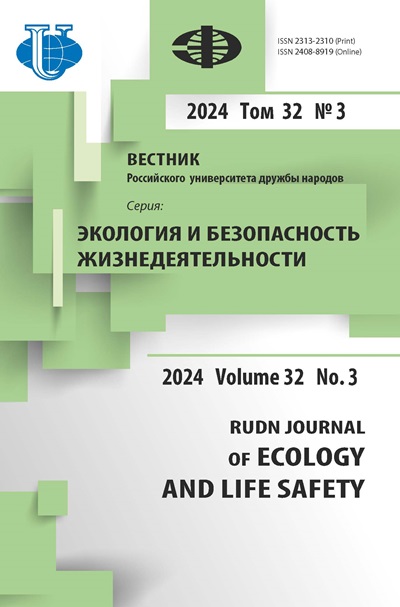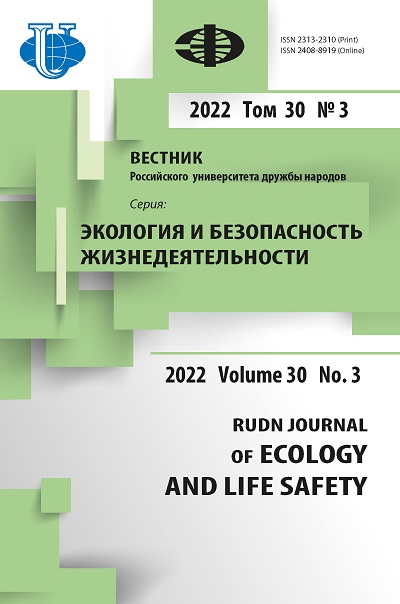Assessment of potential risks to the health of the population of the Baikal region when using products contaminated with antibiotics
- Authors: Timofeeva S.S.1, Timofeev S.S.1, Tyukalova O.V.1
-
Affiliations:
- Irkutsk National Research Technical University
- Issue: Vol 30, No 3 (2022)
- Pages: 312-325
- Section: Human ecology
- URL: https://journals.rudn.ru/ecology/article/view/31892
- DOI: https://doi.org/10.22363/2313-2310-2022-30-3-312-325
Cite item
Full Text
Abstract
Modern ecological problems are considered - pollution of the natural environment with antibiotics and resistance to antimicrobial drugs, when microorganisms mutate and lose susceptibility to antibiotics. The reasons for this dangerous phenomenon are the ever-growing and uncontrolled use of antibiotics in medicine, veterinary medicine and agriculture. Most antibiotics are not completely metabolized in humans and animals, a significant part of the injected drugs enters the water and soil through urban wastewater, animal manure and sewage sludge transported to agricultural fields as fertilizers and pose environmental risks to human health. Assessment of environmental risks from the accumulation of antibiotics in natural waters and food is extremely important for the Baikal natural territory. This is an area that includes Lake Baikal (a World Heritage site), a water protection zone adjacent to Lake Baikal, its catchment basin on the territory of the Russian Federation, natural zones of primary protection adjacent to Lake Baikal, as well as an area about 200 km wide adjacent to Lake Baikal to the west and northwest of it. It may be at potential risk both for endemic species of Lake Baikal and for the population in case of chronic exposure and accumulation of antibiotics in environmental objects. The purpose of this work was a predictive assessment of the environmental risk to public health with direct oral consumption of water, meat and other products grown in an area contaminated with antibiotics. The initial data were the results of monitoring the quality of food products entering the retail network of the Irkutsk region. It was found that on average, an adult resident of the region receives 0.5718 mg/kg of antibiotics daily with food. A child aged 6 to 12 years receives 1.3803 mg/kg of antibiotic daily with food, and a child aged 2 to 6 years receives 2.6686 mg/kg of the substance. Residents of the Baikal region, adults and children aged 2 to 12 years, have a potential environmental health risk as a result of exposure to antibiotics coming with food on the body an order of magnitude higher than the safe level and it is necessary to take actions aimed at minimizing such risks.
Keywords
About the authors
Svetlana S. Timofeeva
Irkutsk National Research Technical University
Author for correspondence.
Email: sstimofeeva@mail.ru
ORCID iD: 0000-0001-8427-3732
Doctor of Technical Sciences, Professor, Head of the Department of Industrial Ecology and Life Safety
83 Lermontova St, Irkutsk, 664074, Russian FederationSemyen S. Timofeev
Irkutsk National Research Technical University
Email: sstimofeeva@mail.ru
ORCID iD: 0000-0001-7085-9468
Senior Lecturer of the Department of Industrial Ecology and Life Safety
83 Lermontova St, Irkutsk, 664074, Russian FederationOlga V. Tyukalova
Irkutsk National Research Technical University
Email: olgaburlak1@yandex.ru
SPIN-code: 6806-7565
Candidate of Chemical Sciences, Associate Professor of the Department of Industrial Ecology and Life Safety 83 Lermontova St, Irkutsk, 664074, Russian Federation
References
- Namazova-Baranova LS, Baranov AA. Antibiotic Resistance in Modern World. Pediatricheskaya farmakologiya. Pediatric pharmacology. 2017;14(5):41–354. https://doi.org/10.15690/pf.v14i5.1782 (In Russ.).
- Global Action Plan to Combat Antimicrobial Resistance. Available from: https://www.who.int/antimicrobial-resistance/global-action-plan/ru/ (accessed: 02.04.2022). (In Russ.).
- Yakovlev SV, Suvorova MP, Beloborodov VB. Prevalence and clinical significance of nosocomial infections in medical institutions of Russia. ERGINI research. Antibiotics and Chemotherapy. 2016;61(5–6):32–42. (In Russ.).
- Sidorenko SV, Yakovlev SV, Spichak TV. Strategy and tactics of rational use of antimicrobial agents in outpatient practice. Eurasian Clinical guidelines. Pediatrics (Appendix to the journal Consilium Medicum). 2017;1:17–25. (In Russ.).
- Gosset A, Polomé P, Perrodin Y. Ecotoxicological risk assessment of micropollutants from treated urban wastewater effluents for watercourses at a territorial scale: Application and comparison of two approaches. International Journal of Hygiene and Environmental Health. 2020;224:113437. https://doi.org/10.1016/j.ijheh.2019.113437
- Ahmad F, Zhu D, Sun J. Environmental fate of tetracycline antibiotics: degradation pathway mechanisms, challenges, and perspectives. Environmental Sciences Europe. 2021;33:64. https://doi.org/10.1186/s12302-021-00505-y
- Mo WY, Chen Z, Leung HM. Application of veterinary antibiotics in China’s aquaculture industry and their potential human health risks. Environmental Science and Pollution Research. 2017;24:8978–8989. https://doi.org/10.1007/s11356-015-5607-z
- Akimenko YuV, Kazeev KSh, Kolesnikov SI, Mazanko MS. Ecological consequences of soil contamination with antibiotics. Bulletin of Samara Scientific Center of the Russian Academy of Sciences. 2013;15(3):1196–1199. (In Russ.).
- Prozherina YuA. Pharmaceutical waste as a new environmental problem. Redium. 2017;(11):14–19. http://dx.doi.org/10.21518/1561-5936-2017-11-14-19 (In Russ.).
- Wang R, Feng F, Chai Y. Screening and quantitation of residual antibiotics in two different swine wastewater treatment systems during warm and cold seasons. The Science of the Total Environment. 2019;660:1542–1554.
- Zhou X, Wang J, Lu Ch, Liao Q, Gudda FO, Ling W. Antibiotics in animal manure and manure-based fertilizers: Occurrence and ecological risk assessment. Chemosphere. 2020;225:12700. https://doi.org/10.1016/j.chemosphere.2020.127006
- Hu Y, Jiang L, Sun X, Wu J, Ma L, Zhou Y, Lin K, Luo Y, Cui Ch. Risk assessment of antibiotic resistance genes in the drinking water system. Science of The Total Environment. 2021 December 15;800:149650. https://doi.org/10.1016/j.scitotenv.2021.149650
- Tatarnikova NA, Maul OG. Antibiotics in food products. Available from: https://cyberleninka.ru/article/n/antibiotiki-v-pischevyh-produktah (accessed: 02.04.2022). (In Russ.).
- Bataeva DS, Zaiko EV. Risks associated with the presence of residual amounts of antimicrobial drugs in meat and animal slaughter products. Theory and practice of meat processing. 2016;1(3):4–10. (In Russ.).
- Timofeeva SS, Shupletsova ID. Forecasting environmental risks of micro-pollutants in the Baikal region. XXI century. Technosphere safety. 2020;5(3):269–283. https://doi.org/10.21285/2500-1582-2020-3-269-283 (In Russ.).
- Timofeeva SS, Gudilova OS. Antibiotics in the environment: state and problems. XXI century. Technosphere safety. 2021;6(3):251–265. https://doi.org/10.21285/2500-1582-2021-3-251-265 (In Russ.).
- Guidelines for assessing the risk to public health from exposure to chemicals that pollute the environment. P 2.1.10.1920-04 (approved by the Chief State Sanitary Doctor of the Russian Federation 05.03.2004). (In Russ.).
- Health risk analysis in the strategy of state socio-economic development monograph / [GG. Onishchenko et al.]; GG Onishchenko, NV Zaitseva (eds.); Russian Academy of Sciences, Federal Service for Supervision of Consumer Rights Protection and Human Well-Being, Federal Budgetary Institution of Science “Federal Scientific Center for Medical-preventive technologies of public health risk management”. Moscow: [B. I.]; Perm: Publishing House of Perm National Polytechnic University, 2014. 737 p. (In Russ.).
- Shokina YuI, Moskvicheva VV, Taseikova OV, Belskaya EN. Definition of environmental quality standards based on a risk-based approach. Bulletin of the Russian Academy of Sciences. 2020;90(12):1146–1155. (In Russ.).
















